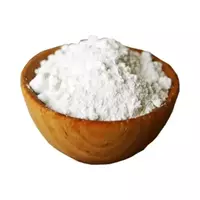Tapioca starch

Have you ever tried a pudding made with tapioca flour or starch? Surely not. In addition, perhaps few have heard about this starch. By the way, tapioca is extracted from the roots of a rather large shrub, which grows exclusively in warm countries. It is called cassava, which in English sounds like cassava, mandioka or yucca.
The roots of the cassava plant mainly consist of 67 percent water and 33 percent starch, and it takes a very long time to make tapioca starch and prepare food from this plant product. First, the roots are thoroughly washed and cleaned, after which they are lowered for several days to soak in a large boiler or river water. Sometimes they can be simply grated immediately after cleaning - as a result, a paste-like mass is obtained, which is fried and often consumed in this form.
But to obtain starch, tapioca are supplied as follows. To do this, the ground mass is mixed several times with the cleanest water and left for a while. After a few days, pure tapioca starch grains settle at the bottom of the vessel, and the dirty water simply drains away. The pure product is re-combined with water and can be repeated up to five times. Then it is dried, packed and exported.
Thus, it becomes obvious that the process of getting this product on our table is quite long and time-consuming, but the price of tapioca starch is quite affordable for our consumer. By the way, we get most of this raw material from Brazil (a national dish is prepared from it - Brazilian cheese bread), from Java and Madagascar.
Tapioca starch is very valuable in cooking. It is considered the cleanest, without foreign impurities, and with a lower proportion of moisture compared to other types of starch, product. In the food industry, it is used quite often as an excellent thickener for soups, sauces and gravy, as well as a binder in the manufacture of meat products. By the way, the low temperature of the thickening process allows the use of tapioca starch in noodles and instant soups.
tapioca starch 358 kCal
Energy value of tapioca starch (Ratio of proteins, fats, carbohydrates - ju):
Proteins: 0.19 g (~ 1 kCal)
Fats: 0.02 g (~ 0 kCal)
Carbohydrates: 87.79 g (~ 351 kCal)
Energy ratio (b | y): 0% | 0% | 98%
 Español
Español Français
Français Português
Português Русский
Русский 简体中文
简体中文 繁體中文
繁體中文 日本語
日本語 한국어
한국어 العربية
العربية Türkçe
Türkçe Қазақ
Қазақ Deutsch
Deutsch Italiano
Italiano Українська
Українська
